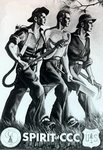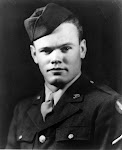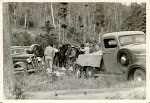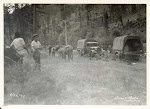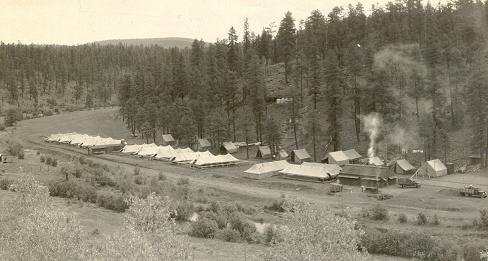 (I must apologize. I've been remiss in my efforts here at Forest Army. What with running the local CCC Legacy Chapter and trying to take in a number of 75th anniversary events, I've neglected the blog. I hope to have more new content posted on a more regular basis for the remainder of 2008. Thank you for your patience.)
(I must apologize. I've been remiss in my efforts here at Forest Army. What with running the local CCC Legacy Chapter and trying to take in a number of 75th anniversary events, I've neglected the blog. I hope to have more new content posted on a more regular basis for the remainder of 2008. Thank you for your patience.)You would be hard pressed to find a more fitting location for a commemoration of the CCC than on the rim of our very own Grand Canyon and you’d be hard pressed to find a better event to mark the 75th anniversary than the CCC Symposium hosted by Grand Canyon National Park May 29th through June 1st. The Symposium marked the opening of an exhibition entitled “It Saved My Life: The Civilian Conservation Corps at Grand Canyon, 1933-1942.” The exhibit is the culmination of a cooperative effort between the National park Service and the Grand Canyon Association.
On opening day attendees were treated to a first look at the CCC exhibit in historic Kolb Studio. The space was packed and visitors young and old marveled at the exhibits and a handful of CCC veterans basked in the spotlight as folks sought them out to hear their story.
On opening day attendees were treated to a first look at the CCC exhibit in historic Kolb Studio. The space was packed and visitors young and old marveled at the exhibits and a handful of CCC veterans basked in the spotlight as folks sought them out to hear their story.
 The following day attendees gathered in the auditorium of the Shrine of the Ages, enjoying a slate of distinguished researchers and historians. Among the presenters: Neil Maher of Rutgers University, author of Nature’s New Deal. Richard Melzer of the University of New Mexico, author of Coming of Age in the Great Depression and Renee Corona Kolvet, author of The Civilian Conservation Corps in Nevada. The slate of speakers also included National Park Service historian John Paige along with Arizona historians Mike Anderson, Peter Booth and Bill Collins. In all, no less than 15 historians, scholars and researchers gave presentations during the symposium.
The following day attendees gathered in the auditorium of the Shrine of the Ages, enjoying a slate of distinguished researchers and historians. Among the presenters: Neil Maher of Rutgers University, author of Nature’s New Deal. Richard Melzer of the University of New Mexico, author of Coming of Age in the Great Depression and Renee Corona Kolvet, author of The Civilian Conservation Corps in Nevada. The slate of speakers also included National Park Service historian John Paige along with Arizona historians Mike Anderson, Peter Booth and Bill Collins. In all, no less than 15 historians, scholars and researchers gave presentations during the symposium. 
For many, the highlight of the day’s presentations was a visit with three CCC enrollees, moderated by Dr. Melzer. Bill Millard, Jim Ware and Willis Canady shared their memories of living and working in the CCC and provided of glimpse of their post-CCC military experiences in the Navy and Marine Corps.
One historian has stated that the work of the CCC advanced park development by as much as 20 years during just the first two or three years of CCC operation, largely due to the massive labor pool provided by the program. As many as four CCC companies operated at Grand Canyon at any one time (on both rims and at the bottom of the canyon) and their list of accomplishments includes structures, trail building, infrastructure improvements like the stone wall in South Rim Village, trail shelters and the trans-canyon telephone line. Again, it’s little wonder that South Rim made such a fitting and majestic setting for such an event; the place fairly oozes CCC history!
We’re all especially indebted to the folks who worked so hard to make this event come together and for their effort in recognizing the important role of the CCC in our nation’s history. Particular thanks goes to the exhibit committee: Mike Anderson, Bob Audretsch, Pam Cox, Pam Frazier and James Schenck.
 Alas, the Symposium events proved far too fleeting as attendees went their separate ways, but the exhibit will continue at historic Kolb Studio until October 19th. If you are at all able to do so, please make the trip to see the exhibit; you’ll be glad you did!
Alas, the Symposium events proved far too fleeting as attendees went their separate ways, but the exhibit will continue at historic Kolb Studio until October 19th. If you are at all able to do so, please make the trip to see the exhibit; you’ll be glad you did!(Photos courtesy of the National Park Service and NPS Staff. Thank you.)
